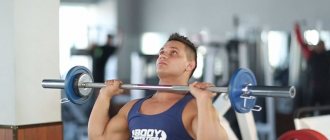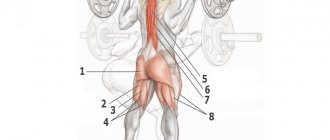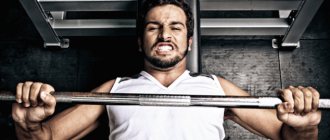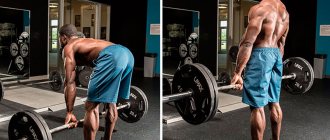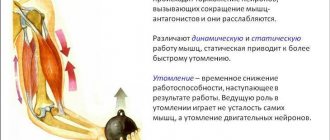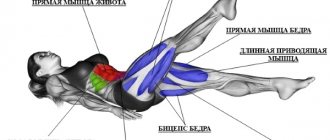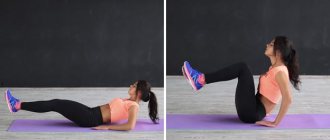Rules for performing the exercise
Ideally correct execution of the bridge exercise is possible with good flexibility and a sufficient level of preparedness. So, the main points of this design of the bridge:
- Arched back. No matter how much it hurts the ears or eyes of experienced strength athletes, in the context of flexibility exercises, it is the maximum convexity and concavity that are indicators of progress;
- The head and shoulders should be lowered below the line of the buttocks, which again characterizes the level of plasticity;
- Limbs clearly fixed on the floor - palms and feet should not come off the floor, they should not be held on the surface by force, the body position should be as comfortable as possible;
- Your palms should be shoulder-width apart from your feet. Of course, such a result cannot be achieved in a week, but if you set a goal and practice regularly, then nothing is impossible;
- Body weight is evenly distributed between the legs, back and arms. You cannot support yourself using only your back - this can lead to injuries, pain, and it also looks ugly;
- Measured breathing without delays.
Exercise Roll over (moving your legs behind your head)
This exercise is no longer for beginners. You should move on to it if the “Shoulder Bridge” and the other exercises described above have already been mastered and are given to you without serious effort. To roll over, the spine should already be quite flexible and the leg muscles stretched. If you have problems with the lower back, neck or thoracic region, or have shortened muscles in the back of your legs, you may want to hold off on this exercise or avoid it altogether.
Lie on your back, arms along your body, stretch both legs vertically up. Press your palms into the floor, pull your legs up, lift your pelvis from the floor, move your legs behind your head. If possible, touch the tips of your toes to the floor behind your head. Pull your legs out of your pelvis, slowly, one vertebra at a time, lower your entire spine and pelvis to the floor, leaving your legs extended to the ceiling. Repeat the exercise 6 times
. If it’s easy for you, stretch your arms behind your head and repeat the exercise with this position of your arms.
How to make a bridge correctly, beautifully and plastically
The main rule when performing a gymnastic bridge is the smoothness and clarity of movements. There is no need to make sudden movements, try to jerk down below the usual level or forcefully “fold”, pulling your legs towards your head. All these points can lead to injury or damage, pain.
The regularity and ease of movements during the execution of the bridge show not only the level of mastery of the technique, but also developed flexibility, a sense of balance, and impart additional elegance and aesthetics.
Making a bridge correctly is not difficult; the ideal execution technique is described above. To perform beautifully, you just need to add smoothness and slowness, as well as fixation in the final position.
Benefits of exercise
The seemingly simple bridge exercise has many positive aspects for health and appearance:
For the most part, our daily activities involve sitting at a workplace, driving, cooking, cleaning, and so on - all these moments are associated with rounding of the spine, leading to the appearance of a stooped back and shoulders, which does not look very aesthetically pleasing. Performing a bridge allows the muscles to bend in the opposite direction, warm up, eliminate problems with intervertebral discs due to weak blood flow in this area, and also restore beautiful posture and straight shoulders;
- The bridge trains many muscles. First of all, the deep back muscles are trained - the rectifiers, the so-called columns. They serve as the main and support for the spine. In addition to them, the gluteal muscles, hamstrings, and muscles of the upper body (shoulders and arms) are used to varying degrees.
- Performing this exercise allows you to stretch almost the entire body at one time - quadriceps, abs, pectoral muscles, even the neck. This is an excellent prevention of osteochondrosis of the cervical spine, which affects most of the modern generation due to sedentary work;
- The development and strengthening of the back muscles allows you to improve the effectiveness and duration of strength training, which is especially important for athletes who regularly perform back exercises with weights (dumbbells, barbells);
- During the deflection of the upper part of the body, the chest “opens”, which has a positive effect not only on posture, but also on the functioning of the cardiovascular system, and also facilitates breathing;
- Regular bending upside down develops the vestibular apparatus, activates blood flow and improves blood supply to the blood vessels of the brain;
- The smallest, but still pleasant moment - the impressiveness of correctly performing a bridge in the gym will definitely attract the admiring glances of all those who do not know how to do it.
History of the German Bridge
The bridge is 18 meters high, 6 meters wide and 85 meters long. This impressive structure is part of the Armavir-Tuapse railway.
The bridge was designed by German engineers, hence its name, and not, as many people think, that the Germans built it during the war for their aggressive purposes.



